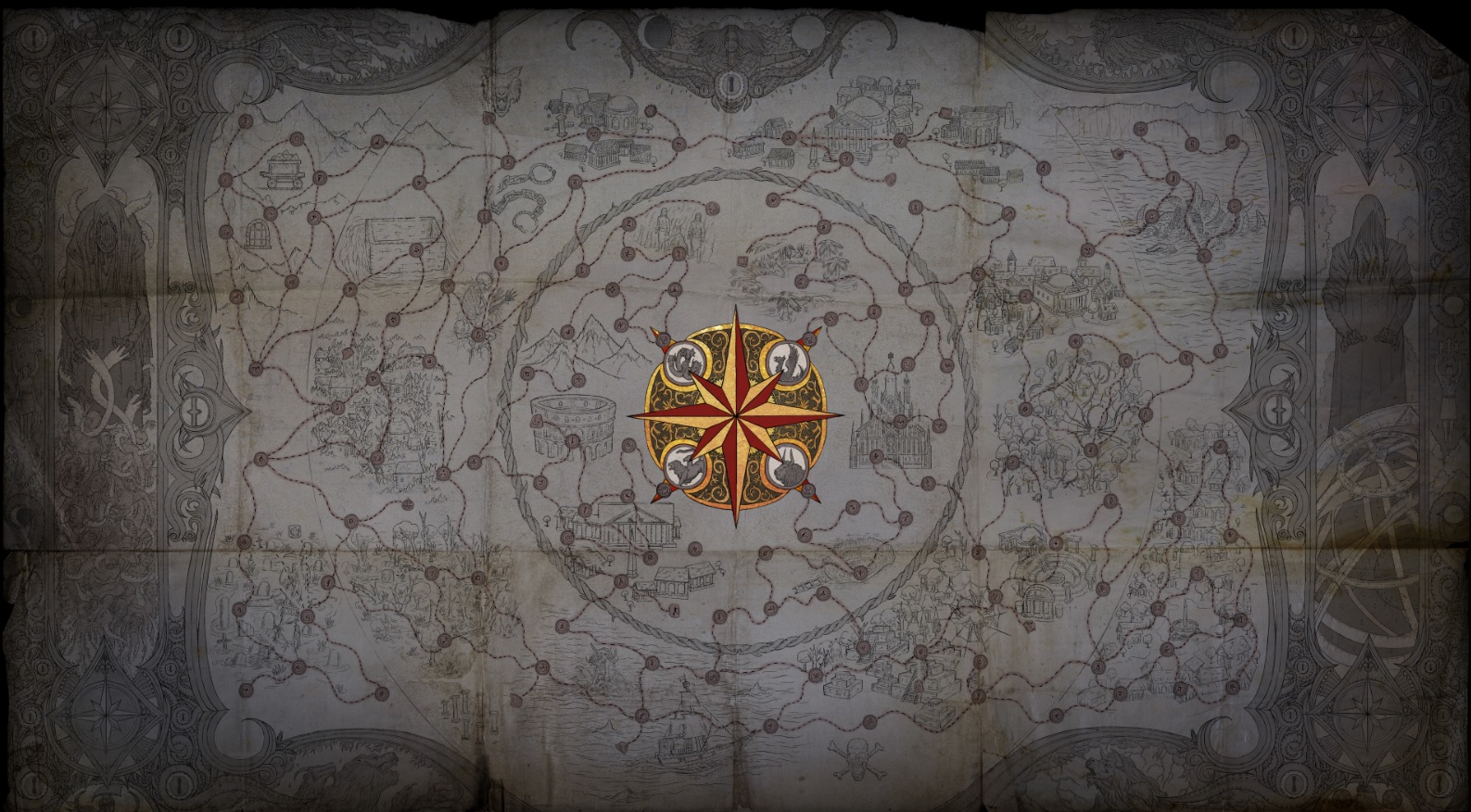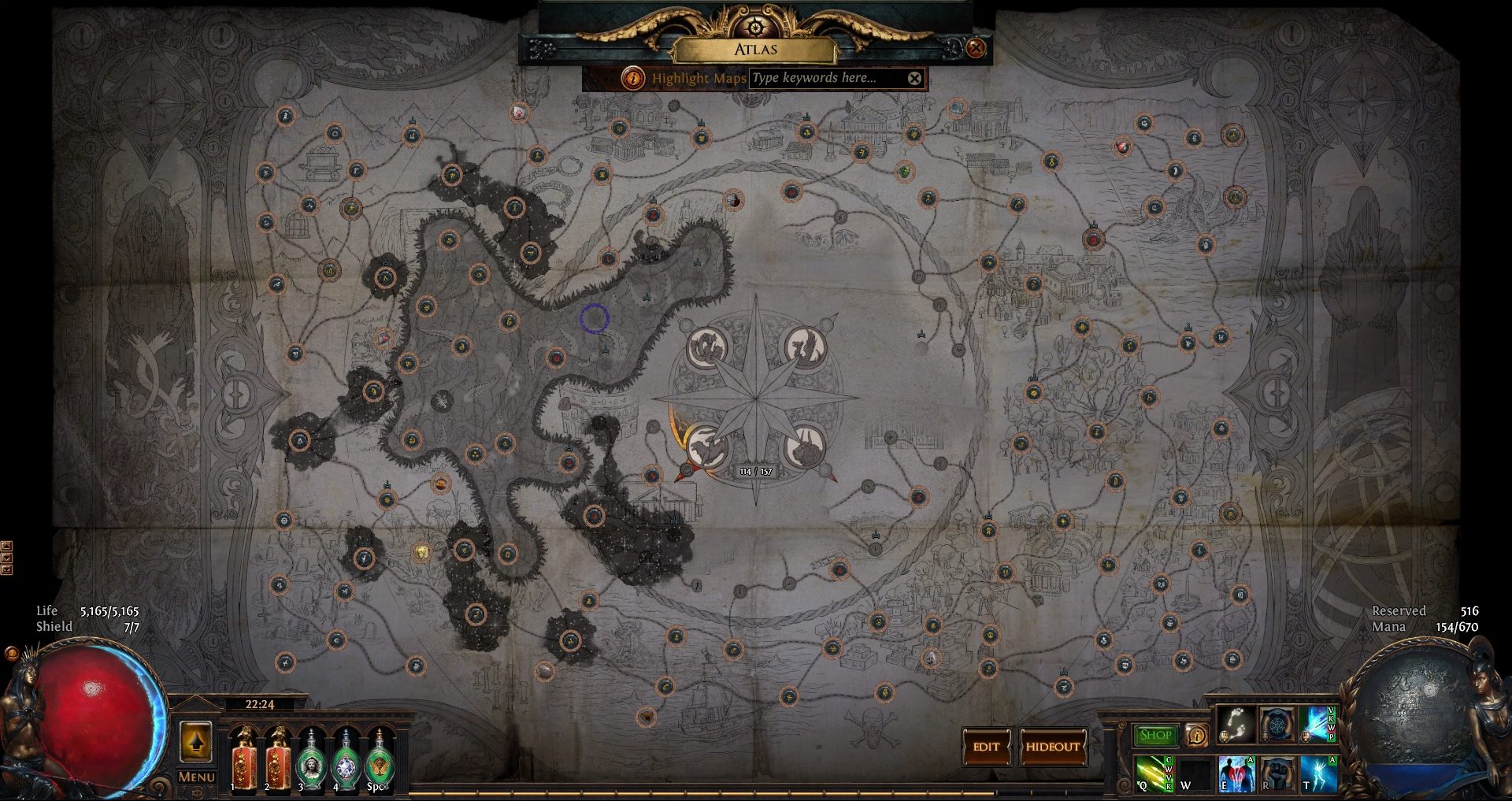With the release of War for the Atlas, a new Path of Exile expansion focused entirely on maps and other endgame content, it’s never been a better time to learn how the Atlas works. Bear in mind that the Atlas is incredibly complicated, and if you’re a new player, it’s completely reasonable to be confused about certain features of the Atlas until you experience it for yourself.
What Is The Atlas?
The Atlas is the endgame for Path of Exile. When you finish the story, around level 70, you gain access to ‘maps,’ which are new zones to run. These are all part of the Atlas, which is really just a large collection of maps that serve as a visual representation of the locations you are visiting.
The Atlas can be accessed from several locations in the game, but primarily you’ll be accessing it through your hideout. Once you finish the story, you’ll be asked to run a map by Zana, who will offer you one. Upon completion, you can invite her to your hideout, where she gives you your own personal map device that lets you safely open maps there.

All of the maps start at tier one, and progress all the way to tier 16. Each of the tier one maps start in the corner of the maps, and you’ll move towards the center, gaining tiers and difficulty as you go. As you make your way through the Atlas, you will encounter all the enemies you fought throughout the story, as well as some new mobs. Same goes for bosses. There are 157 maps on the Atlas, and they’re all packed to the brim with things that want to kill you.
Progressing Through the Atlas
How do you move from tier one to 16? How do you collect maps? Here’s what you need to know:
- Whenever you are in a map of any tier, mobs have a chance to drop maps instead of regular loot. These maps can be the same tier, one tier higher, or any tier lower than the one you’re currently running.
- In other words, if you’re playing a tier 4 map, you have a chance of a tier 5, tier 4, tier 3, tier 2, or tier 1 map dropping. However, the possible map drops only include maps that are connected in some way to the pathways you currently have access to on your Atlas.
- A map gets added to the list of possible map drops once you beat the boss and clear the level.
- The monsters you kill on a map can only drop a map connected to the one you are already running. For example, Graveyard is a tier 1 map that is connected to Marshes, a tier 2 map. In order for me to find my first Marshes (tier 2) map, I have to find it while running Graveyard (tier 1), since the two maps are directly connected. Any mob in a Graveyard map can drop a Marshes map, allowing me to then run Marshes.
- Don’t worry about getting a bunch of copies of maps you’ve already cleared. You can sell three copies of a map to an NPC vendor in order to get a map that’s one tier higher. In other words, if you can’t find a Marshes map, sell three Graveyards for one.
- As you advance, bosses can drop maps that are two tiers higher. However, you need to have actually unlocked the tier in between the current map and the map that’s two tiers higher for this to be possible. There’s no skipping over maps!
- If you have completed a map and killed the boss, then it’s permanently added to the list of maps you can find. So if you’re running a tier four map, you can drop a different tier four map that you’ve completed, even though they aren’t connected. This is great for building up a map pool, but it doesn’t help you move forward on the Atlas.
Atlas Map Tiers and Colors
The 16 tiers of maps on your Atlas are separated into three groups, and each group has a corresponding color. Tiers 1-5 are white, 6-10 are yellow, and 11-16 are red. For the most part, the colors are used to indicate how difficult a specific map is. There are a few specific things that these colors indicate, but if you haven’t unlocked the Atlas yet, all you need to know is that red maps are scary and tough to beat.
You May Like
Most players end up farming maps between tiers 10 and 12 once they reach the endgame. This is because these maps are a high enough tier to give you good loot and experience, but they aren’t excessively difficult. Some players like to grind higher tier maps, especially if they’re using certain builds, but the choice of what map to run is entirely up to you.
Elder and Shaper Influence on the Atlas
Elder and Shaper “influence” was added in Path of Exile’s 3.1 update, and we’re still learning how exactly it works. When you start exploring the Atlas (“mapping”), you’ll quickly see the Shaper influence begin to appear on your maps. When you run an influenced map, you can find new “Shaper items,” and fight stronger versions of the bosses.
Once you get into yellow maps (tier 6 and above), you’ll eventually encounter the Elder. After this, both Elder and Shaper influence will appear on the maps, and the two will start fighting for control of the Atlas. If you run an Elder-controlled map, the Shaper will move in and take it over. If you clear a Shaper controlled map that’s next to one controlled by the Elder, the Elder’s influence will take it over.

Once enough maps are controlled by the Elder, he and his guardians will appear on the Atlas. When this happens, the maps get a visual overhaul, and you can fight the four Elder Guardians, as well as the Elder himself, when you run them. There are three different difficulty tiers of Elders: white, yellow, and red, just like the maps. I’ve been grinding the Atlas since the new expansion was released, and I’ve only faced the white and yellow Elders so far–it was a serious challenge, so I’m expecting the red Elder to be incredibly difficult.
Check back next week for a closer look at two of the most complicated mechanics in the Atlas! And if there’s a Path of Exile topic you’d like us to cover in a future article, don’t hesitate to slide into our DMs on Twitter.
















